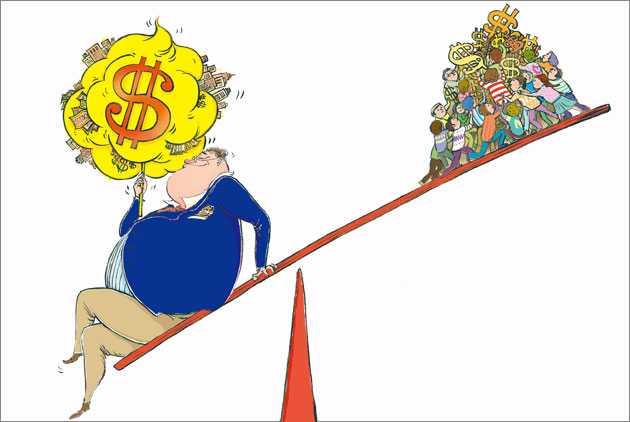Can Taiwan Afford to Rescue Its Middle Class?

Source:CommonWealth Magazine
Calls for more social investment are ringing loudly, but Taiwan's tax system continues to perpetuate injustice. How will the country’s new government cover the hefty check it has written with its trillion-Taiwan dollar reform pledges?
Views
Can Taiwan Afford to Rescue Its Middle Class?
By Peihua LuCommonWealth Magazine
President-elect Lai Ching-te (賴清德) has advocated expanding social investments to rescue Taiwan’s beleaguered middle class, drawing inspiration from Scandinavian countries in pledging to forge a new support system covering all age groups.
From the campaign trail to the present day, however, the new government, which takes office on May 20, has failed to inform the public just how much it will cost to fulfill these campaign promises, so CommonWealth Magazine decided to try to come up with an estimate of its own.
Using government budget documents and estimates from private institutions, we found that just financing social investment projects aimed at alleviating middle-class anxiety, such as a long-term care 3.0 scheme, measures to address declining birth rates, and education equality and housing policies, will cost more than US$10 billion annually.
Beyond that, Taiwan needs to increase spending on defense in response to the evolving geopolitical landscape and subsidize state-owned enterprises facing sizable deficits and labor and health insurance funds that could face bankruptcy in the not-too-distant future. Funding those needs will also cost more than US$10 billion in 2024 alone. The government has also committed to investing US$30 billion from now until 2030 to back a national energy transition.
Added all up, the cost of the new government’s pledges could easily exceed US$32 billion, based on Commonwealth’s conservative estimates, yet the total central government budget is only US$90 billion.
"This is probably the largest check any president has ever written," criticized Taiwan People's Party Legislator Huang Shan-shan (黃珊珊). She believes that if Lai’s government fails to find new sources of revenue, it will either renege on its promises or significantly increase borrowing.
 In an ageing society with fewer children, long-term care will become long-term expenditure, and there is an urgent need to stabilize financial resources. (Photo: Ming-Tang Huang)
In an ageing society with fewer children, long-term care will become long-term expenditure, and there is an urgent need to stabilize financial resources. (Photo: Ming-Tang Huang)
In interviews conducted by CommonWealth with multiple legislators, everyone agreed these investments were necessary, but when asked where the money would come from and whether taxes should be raised, they dodged the questions.
"It's as if the government has been telling the people that they can have a free lunch, offering abundant benefits while also cutting taxes," said Joe Chen (陳國樑), head of the Department of Public Finance at National Chengchi University, with palpable frustration.
Does Taiwan really have the means to emulate Scandinavian countries and embark on a social investment spree?
Probably not, in terms of either taxation or borrowing.
First, Taiwan is a low-tax haven even when compared to Singapore.
Lower Taxes than Tax Haven Singapore
When including social security contributions like labor insurance and national health insurance, Taiwan's tax revenues as a percentage of GDP totaled only 19 percent, the lowest in Asia.
That’s also far below the tax rate in Scandinavian countries that the new government wants to emulate. In Denmark, tax revenues accounted for 47 percent of GDP in 2021, a ratio 2.5 times higher than Taiwan’s.
Taiwan has emerged as one of the countries with the lowest tax burden in the world because many other governments have raised taxes in recent years in response to aging populations.
Chen said developed countries have realized that as their labor forces shrink over time, income tax revenues will fall, necessitating higher consumption taxes to make up the shortfall.
In Asia, Japan has led the way by gradually raising its consumption tax rate from 8 percent to 10 percent starting in 2019, while Singapore has raised its rate from 7 percent to 9 percent.
In contrast, Taiwan's sales tax rate is 5 percent, the second-lowest globally, higher only than in Andorra, which has a population of 80,000.
Lagging Behind in Taxing the Wealthy
“Demographics have a huge impact on public finances. As the number of taxpayers decreases and the number of tax recipients increases, the government's financial pressure will undoubtedly increase," said former Legislator Tseng Chu-wei (曾巨威), an expert on tax and financial issues.
He recently approached the Ministry of Finance to calculate Taiwan's fiscal deficit for the next 50 years.
Another trend is taxing wealth. Five years ago, an OECD report titled "Under Pressure: The Squeezed Middle Class” described how the global middle class has struggled as their incomes failed to keep up with the rising cost of living. The report recommended expanding the taxation of income from capital and capital gains, lowering exemptions for inheritance taxes for the wealthy, and implementing tax credits for labor income.
The report pointed out that in OECD countries, the effective tax rate on the wealthy is lower than that on the middle class because a significant portion of their income comes from returns on capital, and the tax rate on these capital gains is much lower than on labor income.
Iceland has tried to reverse the trend, increasing its capital gains tax rate by 2 percentage points to 22 percent in 2018.
A similar concept is reforming inheritance taxes. Japan, for example, cut the tax-free exemption for high-income groups by 40 percent in 2015, which reduced the transfer of hereditary wealth and increased tax revenues.
Singapore has also targeted the wealthy to increase its fiscal revenue. After raising property taxes on luxury homes, it imposed an additional registration fee on imported luxury cars such as McLarens and Lamborghinis.
 Taiwan's rent tax is not enough and unfair. The rich only have to pay a very small amount of tax when they buy a luxury home. (Photo: Ming-Tang Huang)
Taiwan's rent tax is not enough and unfair. The rich only have to pay a very small amount of tax when they buy a luxury home. (Photo: Ming-Tang Huang)
Taiwan might want to also consider taxing the rich, having yet to do so in a meaningful way.
Using the research methodology of the World Inequality Database to calculate Taiwan's wealth gap from 2004 to 2020, professors from National Chengchi University and Academia Sinica found that the wealthiest 10 percent in Taiwan held over 60 percent of national wealth, and that their share has steadily increased.
They also found that real estate is the main source of growth in wealth for Taiwan's richest individuals, yet they have seemingly been spared by the tax code.
Taiwan's most recent tax reform was to create a joint real estate transaction tax, seen as the first step in reforming the land tax system. The result, however, has been that property holding taxes have actually fallen rather than increased.
Unlike the joint real estate transaction tax, which is only levied when a property is sold, property holding taxes consist of the land tax and house tax and are assessed annually on property owners.
Buy a Luxury Home, Pay Less in Taxes
These holding taxes have remained low in part because they are imposed based on the government-assessed “current value” of properties rather than their actual market values.
Fu Chien-hao, an assistant professor in National Chengchi University’s Department of Finance, analyzed Taiwan's property tax system and found that in nearly half of Taiwan’s counties and cities, the taxable current value was less than 10 percent of the market value.
"By international standards, Taiwan's property holding taxes as a percentage of total tax revenue are unhealthily low," he said bluntly.
He also discovered that the higher the price of real estate, the greater the difference between the taxable current value and the market value. For lower priced properties, their current value averaged 30-40 percent of their actual value, while for luxury homes it was only 10 percent.
This means that the tax burden on those who buy luxury homes is actually lighter than on those who purchase less expensive properties.
Foreign studies have shown that increasing property holding taxes can help curb housing prices because the higher taxes lower the return on investment of a house, leading to more conservative offers and purchase prices.
Legislators from Taiwan’s three main parties acknowledge that housing injustice is the biggest problem facing Taiwanese society, but they all have reservations about raising property holding taxes.
While social investment aims to reduce the burden on the middle class and address inequality, Taiwan's tax system seems to exacerbate inequality.
"Income redistribution is essentially robbing the rich to aid the poor. Giving money helps the poor, while taxation is robbing the rich, but we have only helped the poor without properly robbing the rich, effectively giving the wealthy a bargain," criticized Tseng, the former legislator.
Borrowing at a Limit despite Annual Tax Revenue Surpluses
The only tax that has garnered some legislative consensus is a carbon tax.
Legislators from both the ruling and opposition parties agree that the Ministry of Finance should not abandon the idea of carbon taxes, especially since they have become an international trend. Tseng recalled that the tax reform commission convened in 2008 suggested levying energy and environmental taxes, estimating they could generate US$ 3 billion in tax revenue annually.
Finance Minister Chuang Tsui-yun has indicated, however, that while Taiwan will take the lead on carbon fees, it has no plans to levy carbon taxes, extinguishing the chances of a tax hike.
If taxes cannot be raised in the short term, could Taiwan, which has declared tax revenue surpluses in recent years, consider borrowing to finance social investment?
Looking at the data, Taiwan's debt as a percentage of GDP has indeed declined, but according to the Finance Ministry’s latest national debt clock, average per capita debt is US$8,290, an increase of US$920 from eight years ago.
Crisis: Increasing Spending without Tax Awareness
A former finance minister said Taiwan's greatest fiscal crisis is that the government has grown accustomed to spending lavishly in recent years, buoyed by the semiconductor boom and robust tax revenues.
Based on government budget documents, spending has grown 7.2 percent, 21.5 percent, and 6 percent a year, respectively, over the past three years, far exceeding the average growth rate of about 2 percent over the past decade.
During that time, a significant source of revenue has come from opportunistic gains. In 2020, securities transaction tax revenue exceeded US$4.6 billion for the first time, and it then increased by more than US$ 3 billion, or 83 percent, the following year.
"But semiconductors cannot thrive forever, and fiscal fortunes can turn in the blink of an eye," warned the former finance minister.
In the 1980s, when Taiwan's economic boom times came to an end, its fiscal situation deteriorated rapidly. The long-term debt ratio increased from 6.9 percent to 28 percent in just 10 years, and there is no guarantee history will not repeat itself.
In fact, sustained expenditures require stable revenue sources over the long term.
"Taiwan relies on conservative fiscal management and foreign exchange reserves to maintain a good credit rating," said a retired financial official, emphasizing the importance of sound fiscal policy, especially for Taiwan, which is isolated in the international arena.
Have you read?
- Rescuing Taiwan's Anxious Middle Class
- How can Taiwan’s National Health Insurance program be saved?
- The fight in Taiwan for better migrant worker conditions
Translated by Luke Sabatier
Uploaded by Ian Huang





